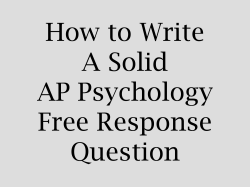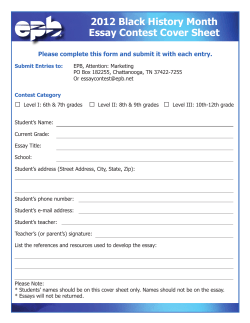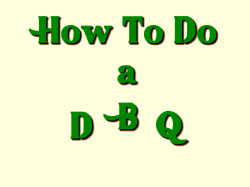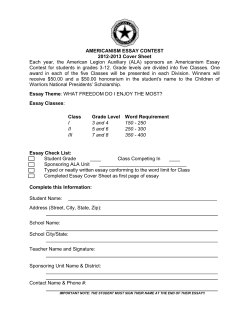
How to Approach AP Lit. Essays
How to Approach AP Lit. Essays Prose/ Poetry Essay • Work the prompt: be sure you clearly understand what the prompt is asking you to do • Take 5-10 minutes to read and annotate the poem. Annotations should help establish patterns and point out literary elements/techniques and poetic devices Poetry Essay • Develop a thematic statement that gets at the heart of the poem’s message. • Consider: What techniques/elements does the poet use to convey this message? THESIS (i.e.: Robert Frost’s use of imagery, symbolism, and tone illustrate man’s simultaneous fear and acceptance of death.) Prose/Poetry Essay • Remember: You must use quotes as supporting evidence! • Structure for integrating quotes: I-Q-E • Introduce the quote with background, context, your own assertion. • Quote the poem directly. • Explain the quote’s significance in relation to your thesis Essay 3: Free-Response • Based on a literary work of your choice (you do not have to use the suggested works in the list). • Carefully read the prompt! It may ask you to analyze techniques or it may be “TOPICAL.” • Example of a topical prompt:”A recurring theme in literature is the classic war between passion and responsibility. For instance, a personal cause, a love, a desire for revenge, a determination to redress a wrong, or some other emotion may conflict with moral duty. Choose a literary work in which a character confronts the demands of a private passion that conflicts with his or her responsibilities. In a well-written essay show clearly the nature of the conflict, its effects upon the character, and its significance to the work. Essay 3: Free-Response • Begin with a thematic statement that is clearly related to the prompt but is not a simple restatement. Get right into the “meat” of your argument. Essay 3: Free-Response • • If the prompt is topical, organize by topics indicated within the prompt. If the prompt asks you to analyze elements or techniques, organize accordingly. Write a working thesis/thematic statement What will you prove in your essay? Avoid simply restating the prompt. Instead, attempt a thematic statement that gets at the heart of what the work is saying. Put the prompt into your own words Ask yourself: “What this prompt is asking you to do/analyze?” Underline key words or separate questions or tasks within this prompt if it is multifold. Rewrite your answer to this question next to the prompt in your own words. Avoid using words that are in the original prompt unless it is absolutely necessary. Developing a few thematic statements 3 x 3 exercise: Summarize your story in THREE sentences! Rather than stating events, focus on the universal truths the author seems to be unveiling through the actions of the story DON’T •Minnie kills husband. •Men seek evidence. •Women hide evidence. This summary follows the correct structure of a 3x3 literary summary, but it fails to get at the deeper issues of a text. It states the beginning, the middle, and the end of the story “A Jury of Her Peers.” DO •Apathy strangles devotion. •Tidiness uncovers truth. •Sympathy chokes justice. OR •Unpredicted fate evolves. •Curiosity unearths reality. •Empathy conceals truth. OR •Guilt consumes women. •Curiosity unveils evidence. •Lost heart’s saved. This summary not only follows the correct structure, but it unveils the thematic truths that the story conveys. Write your 3x3 literary analysis Will Use complete sentences effective word order strong words, especially verbs and adjectives May Use abstract nouns contractions using “is” Will NOT Use proper nouns/names repeated words “to be” verbs pronouns (It, he, she).. clichés a, an, the Some things to remember when writing a thematic statement Topic vs Theme: A topic is a subject of a work (love, war, race, innocence, violence); A theme is what the author has to say about that topic. What is the major topic illuminated/illustrated in your work of literature? What is the author trying to say about this topic? You can follow the steps on how to write a thematic statement from the handout we used during our poetry unit. How will you prove your thematic/thesis statement is true? Brainstorm proof! Consider how the author utilizes literary elements or techniques to illustrate his/her beliefs. You may need to consider the direction of the prompt here (some prompts say to focus on a symbol, character, etc.) Consider the interrelatedness of some of these literary elements or techniques. (An author’s tone/attitude is often revealed through diction, character choices or motivations, etc.) Shift your language in how you discuss literary elements Critical Lens Through William Golding’s use of characterization, he shows his belief that mankind is inherently evil. AP Style Golding conveys his cynical, pessimistic belief of mankind’s inherent evil through his characterization of Jack, a jealous, blood-thirsty young boy. Characterization (Who: tell me right away!) Characterization (Jack: jealous, Tone (attitude /“his belief”: briefly blood-thirsty young boy) describe in an adjective or two) Tone (Golding’s cynical, pessimistic Theme (nature of man: clearly belief) stated) Theme (nature of man) Decide which elements/techniques BEST support your thematic statement(s) Characterization Conflict Tone Setting Diction Syntax Structure Point of View Foreshadowing/Flashback Symbolism Figurative Language Etc... Support Once you’ve decided which elements or techniques you will analyze in your essay, you will gather and organize your supporting evidence. You should organize your body paragraphs by topic (literary elements; supporting claims in relation to thematic statement or prompt; etc) Within each body paragraph: Orientation, Claims, Evidence, Commentary Start with a topic sentence that previews what will come in this paragraph. Offer the reader an orientation to your idea: who is speaking (it may be the narrator), to whom, what is the context? Make an insightful claim about something in the text that fits the prompt. Present the evidence from the text—often you will need more than one piece to support your claim. Shoot for three: Your evidence may be a phrase; It may be a passage; It may be purposeful summary. Follow each piece of evidence with a minimum of two sentences of your own commentary and analysis of how the evidence supports your claim and the question you are answering. Basic Organizational Structure Introduction: Thematic/Thesis Statement, Preview Supporting Arguments Do not make broad generalizations about the nature of literature or how literary elements “ADD DEPTH” Say much in few words. Five to six sentences should suffice. Basic Organizational Structure Body Paragraphs: Start with a topic sentence (introduce the key idea of that paragraph) Orient the reader by providing context Claim-Support-Analysis Provide a balance of YOUR IDEAS and supporting textual evidence Use transitions Conclusion FIRST: Summary Statement: look at your thesis statement again and rework it in a new way. Avoid repeating key words and phrases from the thesis statement because you don't want the summary statement to sound boring or repetitive. Using a thesaurus is a good way to find new, interesting words. LAST: Clincher Statement: also referred to as the closer, is your last opportunity to connect with the reader. One way to make the most of this moment is to return to the technique you used for your grabber. Click on each type to read examples. Anecdote. Make a prediction or recommendation based on the analysis you’ve offered Ask a final rhetorical question. Use a new (but relevant) quotation or refer back to the opening prompt. Continue the original description of a character, setting, or object, but in a way that gives a sense of finality or encourages the reader to continue thinking about the subject. General Tips Mention the Title (full length=underlined, short works=quotation marks) and Author in the Intro Use strong action verbs; avoid forms of “To Be” (is, are, will be, was, were has been, etc) Use strong adjectives but avoid adverbs (what is the difference between a character who is deceptive and one who is EXTREMELY deceptive or VERY deceptive? Does it matter?) This will help reduce wordiness. Transition between and within paragraphs. Use a variety of transition types (chronological indicators, repeating word order, jumping off a previous idea, etc) Be concise. Say as much as you can in as few words as you can. Aim for clarity in your writing. Taking 10 minutes to prewrite will help give your essay a clear focus. Use any leftover time to edit! Put one line through anything you do not want to be read. Avoid scribble .
© Copyright 2025










